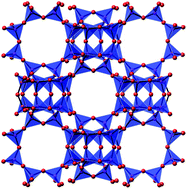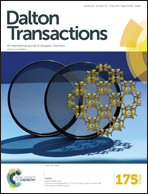Structure and properties of ITQ-8: a hydrous layer silicate with microporous silicate layers†
Abstract
ITQ-8 is a new hydrous layer silicate (HLS) with a chemical composition of [C4H8(C7H13N)2]8 [Si64O128(OH)16]·48H2O per unit cell. The synthesis of ITQ-8 was first described in 2002 by Díaz-Cabañas et al., the structure of this material, however, remained unsolved at that time. Physico-chemical characterization using solid-state NMR spectroscopy, SEM, TG-DTA, and FTIR spectroscopy confirmed that ITQ-8 is a layer silicate. The XRD powder pattern was indexed in the monoclinic system with lattice parameters of a0 = 35.5168(5) Å, b0 = 13.3989(2) Å, c0 = 16.0351(2) Å, β = 106.74(2)°. The crystal structure was solved by simulated annealing. Rietveld refinement of the structure in space group C2/c converged to residual values of RBragg = 0.023, RF = 0.022 and chi2 = 2.3 confirming the structure model. The structure of ITQ-8 contains silicate layers with a topology that resembles a (11–1) section of the framework of zeolite levyne. So far, this layer topology is unique among layer silicates. The layer can be regarded as made up of 4-, 6-, double-six and 8-rings which are interconnected to form cup-like “half-cages”. Unlike other HLSs, which possess impermeable silicate layers, ITQ-8 contains 8-rings pores with a free diameter of 3.5 Å × 3.4 Å and can be regarded as a “small-pore layer silicate”. In the crystal structure, the organic cations, 1,4-diquiniclidiniumbutane, used as structure directing agents during synthesis are intercalated between the silicate layers. Clusters (bands) of water molecules which are hydrogen bonded to each other and to the terminal Si–OH/Si–O− groups are located between the organic cations and interconnect the silicate layers. ITQ-8 is a very interesting material as precursor for the synthesis of microporous framework silicates by topotactic condensation or interlayer expansion reactions leading to 3D micro-pore systems which may be useful in applications as e.g. catalysts, catalyst supports and adsorbents of for separation.


 Please wait while we load your content...
Please wait while we load your content...